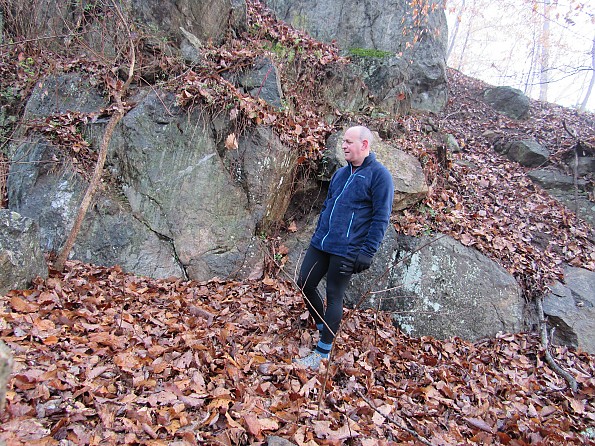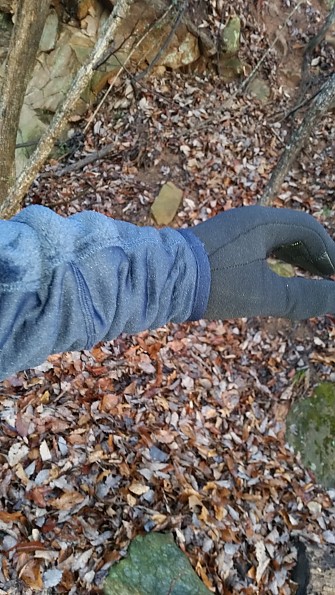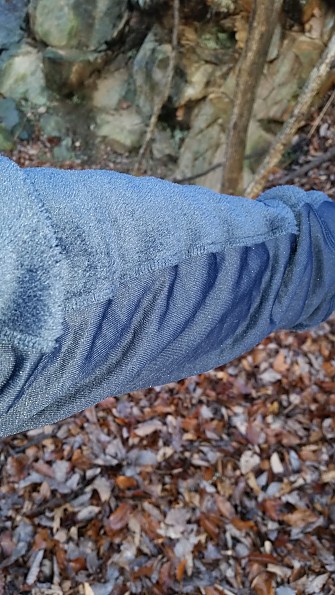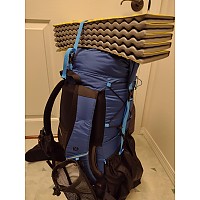Patagonia R3 Jacket
The R3 Jacket has been discontinued. If you're looking for something new, check out the best fleece jackets for 2025.
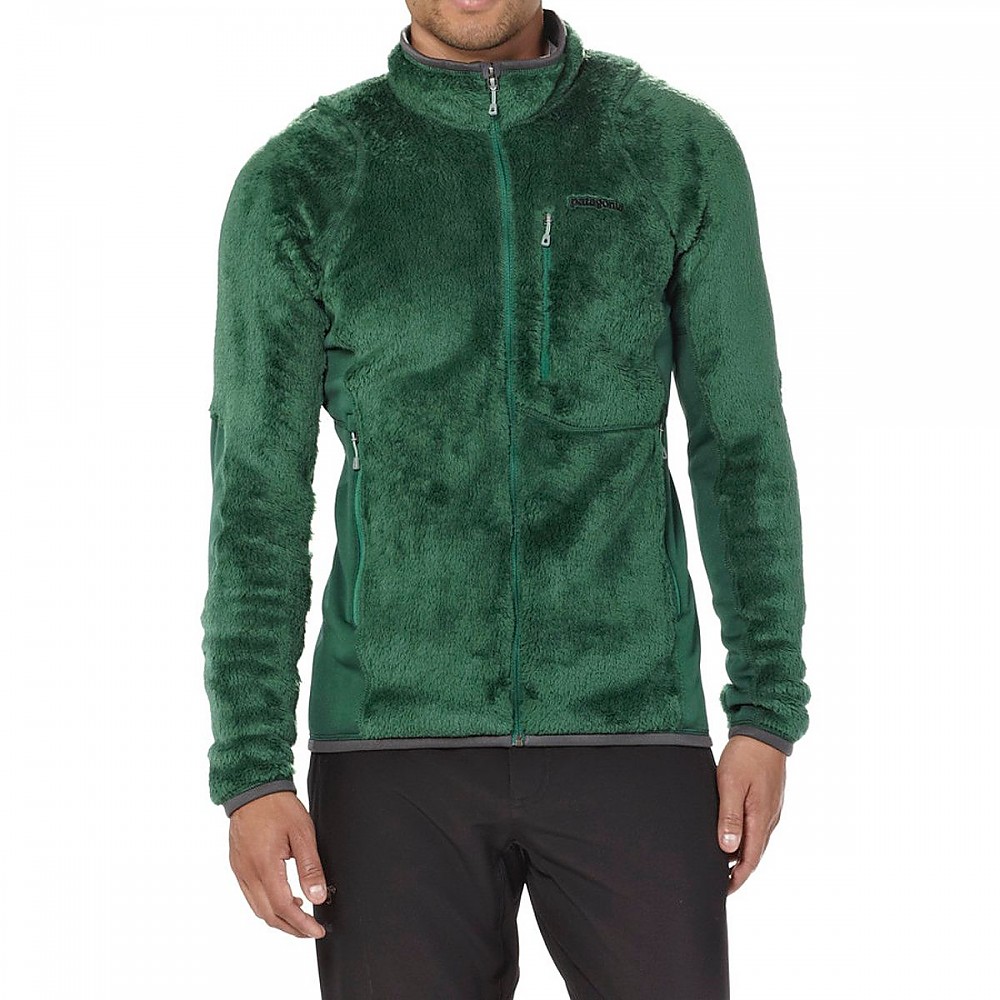
Athletic cut synthetic fleece jacket that was made for working hard in cold weather. You can wear this in a wide range of temperatures because it is very warm under a wind shell, yet it lets air and moisture through easily as an outer layer. I particularly like the smart hybrid use of fuzzy fleece in some areas and stretchy, high-wicking grid fabric in others. Typical high quality jacket from Patagonia. NOTE: at least as of spring 2017, this is only available as a hoody.
The only weakness? Synthetics you use for high-output activities get smelly, and this is no exception.
Pros
- Warm, but handles wide temperature range
- Excellent for handling sweat and moisture
- Outstanding construction
- Great freedom of movement
Cons
- Athletic fit and narrow cuffs might bother some people
- Starts to smell after extended hiking
- Spendy
For the last several months, I have worn this jacket as a primary warm layer in cool weather and under a shell on some of the coldest days we have seen. Functionally, it is one of the most versatile and high-performing fleece jackets I have used.
It is quite a bit lighter than a warm old-school 300 weight fleece like The North Face Denali, but just as warm. The closest comparison/competitor I’m aware of is Mountain Hardwear’s Monkey Man fleece jacket.
Basic Details and Fit:
My size XL weighs 14.4 ounces using an electronic hand scale. For the sake of comparison, that’s about ten ounces lighter than The North Face’s burly Denali fleece jacket, about 7 ounces lighter than Ibex’s fabulous and warm merino wool Nomad hoody full-zip, and an ounce or so lighter than Patagonia’s Nano Air Hoody.
I’m 5'9" and 210 pounds, not a narrow person. XL is the right size, enough room for a long sleeved base layer, even a thicker one like an expedition-weight top or Patagonia’s lightest R1 fleece. If you are a larger/broader person, consider going a size larger and definitely try it on to make sure the athletic fit works for you.
The fabric is quite stretchy, though, and it is super comfortable to wear. It definitely won’t hamper your movement, and the athletic fit means it layers easily under shell jackets.
The sleeves are a little longer than average, with simple elastic cuffs. The jacket doesn’t ride up at all when you raise your arms. One of the more interesting things about this jacket is the hybrid use of fuzzy Polartec Thermal Pro in the front, back and top portions of the sleeves, and Polartec Power Dry (a thinner, stretchier grid fleece) on the cuffs, bottoms of the sleeves, and side panels. More on how that affects the jacket’s performance below.
I normally hunt for jackets on sale and often sacrifice by finding less appealing colors. Couldn’t find this on sale, which was painful. But, I like the navy blue.
A Little More About Function and Features:
The design is fairly simple – full zip front that fits your neck snugly when zipped all the way up. Two handwarmer pockets and one chest pocket, all backed with perforated soft nylon, and all the zippers have pulls that are very easy to handle with gloves. The neck has grid fleece on the inside and fuzzy fleece on the outside, which adds some warmth there.
The ends of the sleeves are all grid fleece. This means the cuffs are stretchy and feel fitted, not loose—some might not like that. I like them a lot—cuffs tend to get a lot of wear, so I’m pleased to see that the more durable material in a high-wear area. Also, it means this jacket has less bulk at the ends of the sleeves, meaning they work well under a shell using gauntlet gloves in colder weather. The hem length of this jacket is a little longer than normal, falls about to my hips, and is mildly stretchy.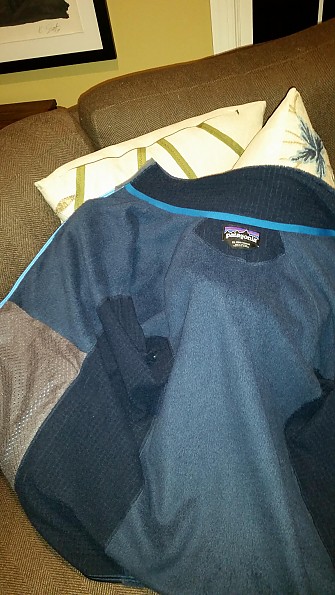
Inside view shows the different types of fleece. The gray material is the back of the pocket.
Warmth/Temperature Handling:
This jacket is good in a wide variety of temperatures on the cooler end of the spectrum. It’s too warm to wear on a balmy fall or spring day, but as the temps drop into the 50’s, it is a good outer layer to cut the chill if you are standing around. Ditto for a cool summer evening in Northern New England.
As you move into the 40s and 30s, this jacket works well as an outer layer for hiking, so long as the wind isn’t blowing too hard. Air moves through the fabric easily, so a colder breeze can feel very chilly in this jacket. Worn under a shell, it is very warm—almost too warm for an aggressive hike, unless it’s quite cold out. If I’m moving hard uphill, the R3 works really well in cold weather, teens and twenties.
One great benefit of the hybrid fabric is that the places you sweat the most, armpits and inner areas (sides and insides of arms) have thinner fabric that is better suited for wicking sweat out. I’m not suggesting you can’t or won’t sweat in the R3 jacket, but it does a better job than almost any other fleece I have worn at handling the sweat and keeping me warm and comfortable.
One flaw that is inherent in any synthetic fleecy layer is odor. Like any shirt or jacket made with Polartec Power Dry, it will start to smell after a while. That said, this is very easy to launder. I hang it up to dry.
Testing Conditions:
I wore this jacket at a few summer campfires and some chilly evenings on Martha’s Vineyard. In the fall, I used this as an outer layer or mid-layer at soccer games and on many hikes in Maryland and Virginia. This winter, I layered the R3 over a merino wool t-shirt or a long-sleeved base layer, usually a Patagonia Capilene 3 or an Ibex 200 gram wool long sleeve merino shirt, and under a wind shell for hikes on really cold or windy days.
I more or less expected to wear this jacket over this temperature and weather range, but I was a little surprised at how warm it is, warmer than I expected, almost on par with Patagonia’s Nano Air. (I have had the Nano Air for a year and a half and plan to review that soon—it serves a very similar purpose in a somewhat different way).
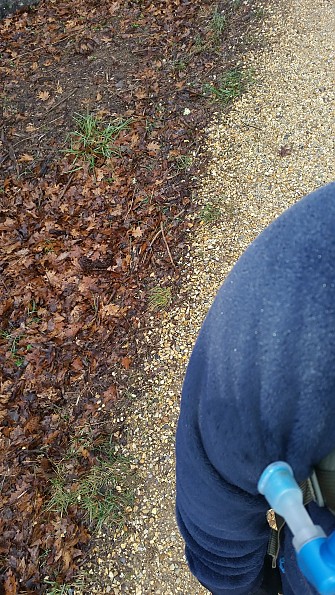
Note how my shoulder has a layer of moisture on the surface—wicking out on a 35 degree hike.
Zipped all the way up under a shell on a sunny but windy and very cold morning. Nice look at the zipper pull, they're the same on the pockets.
Cost/Quality:
Patagonia’s quality remains excellent. The fuzzy body of this jacket looks like it could wear badly; mine has spent plenty of time under pack straps and hip belts with virtually no visible wear. Use it frequently, use it hard, and it’s going to last for years. If it doesn’t, Patagonia’s lifetime warranty is for real. Keep that in mind if you swallow hard and pony up the $180+ full retail price. For a fleece jacket, yikes.
Conclusions:
Super versatile, warm for a fleece, excellent at venting moisture, this jacket is a 3-season winner...if your seasons are fall, winter, and spring. If you want the most versatility in a Patagonia fleece and don't need so much warmth, Patagonia's R1 Hoody or R1 Pullover are usable over a wider range of temperatures. This remains one of my favorite fleece jackets every for colder weather. Try one on to make sure the somewhat narrow fit and cuffs work for you.
Source: bought it new
Price Paid: $180
Your Review
You May Like
Specs
| Men's | |
|---|---|
| Price |
MSRP: $179.00 Historic Range: $77.56-$200.00 Reviewers Paid: $180.00 |
| Weight |
16.7 oz / 473 g |
| Body Fabric |
7.4 oz Polartec Thermal Pro 98% Polyester, 70% Recycled / 2% Spandex |
| Side Panels |
6.6 oz Polartec Power Stretch 88% Polyester, 60% Recycled / 12% Spandex |
| Women's | |
|---|---|
| Price |
Historic Range: $75.60-$200.00 |



